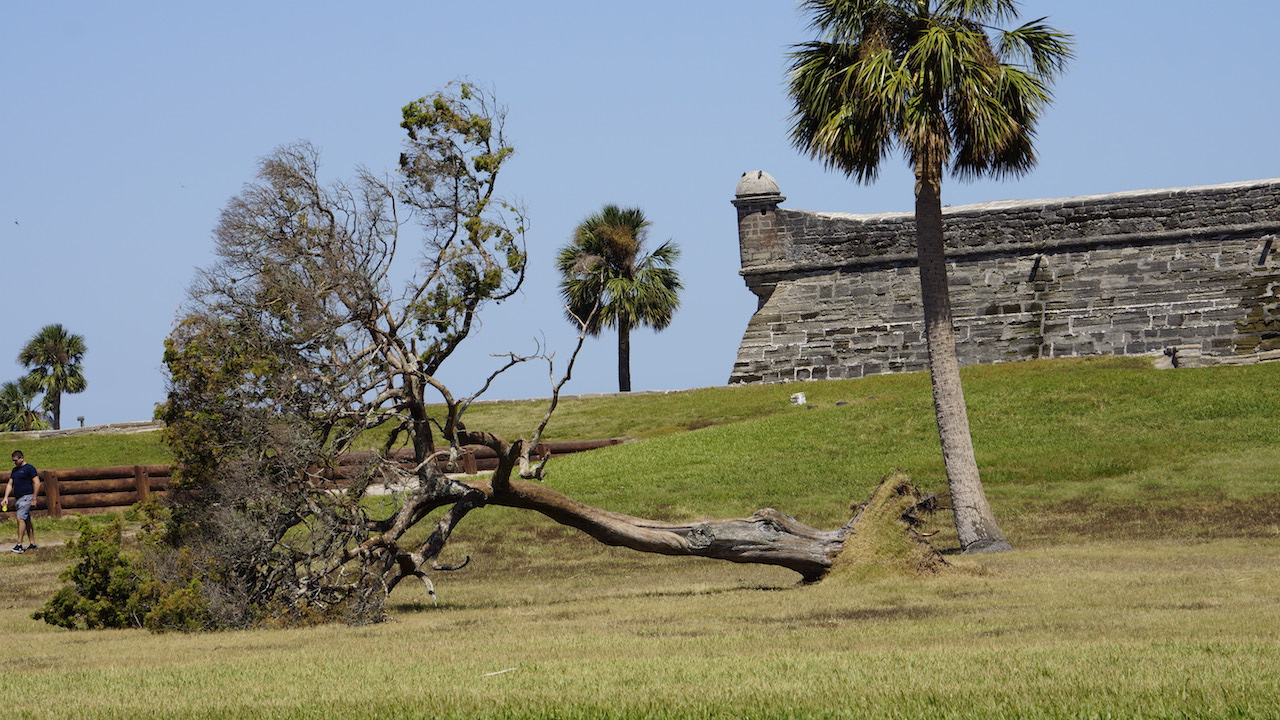By Katie Garwood | gargoyle@flagler.edu
As she surveyed the city after Hurricane Irma, St. Augustine Mayor Nancy Shaver found her city’s residents in a much different state of mind than after Hurricane Matthew last October.

A tree rests on the ground after being blown over during Hurricane Irma. Taken Sept. 14, 2017, photo by Katie Garwood.
“When I talked to people after Matthew, people were upset, they were frantic, they were confused,” Shaver said. “This time, people have really just been through it.”
While it may not have seemed that way at the time, for many, Hurricane Matthew served as a wake-up call. Because of the storm, both residents’ and officials’ preparation and response to Hurricane Irma was overall a more educated and coordinated effort, Shaver said.
In terms of damage, it’s still too early to tell which storm was more destructive to homes and businesses. Throughout the city, some homes and businesses experienced flooding, as well as downed trees, loss of power and damage to roofs from winds.
St. Johns County Emergency Management Director Linda Stoughton said Irma brought more wind and widespread damage to the county than Matthew, but Irma’s storm surge was around 18 inches less. Davis Shores, Crescent Beach, North Vilano Beach and Flagler Estates in Hastings were among some of the areas with the most damage.
From an emergency management standpoint, Hurricane Irma was handled differently, but in an improved way, Stoughton said. This year, the EOC discontinued the re-entry tag program they’d been using since 1999 to allow residents back onto the barrier island. The EOC also tried to make the possibility of storm surge on all three bodies of water in the area – the Atlantic Ocean, the intracoastal waterway and the St. Johns River – more clear to residents.
“Before Matthew, we had an inexperienced population that had not had a storm in over 10 years,” Stoughton said. “We hate to see (that) this one came prior to even being the year anniversary of Matthew, but the community was ready.”
Shaver said “hundreds” of things were different with the way the city responded to Irma, many of which the public would never see. Communication between the city, county, and emergency operation center was “night and day.” The city’s Public Works department worked with Florida Power & Light to notify where downed trees and power lines were, which last year didn’t happen as smoothly.
“Last time, I was driving the city finding downed trees and I’d go out to the EOC and tell them where they were,” Shaver said.
As far as things the public would see, there were also numerous changes. The city closed from U.S. 1 to King Street as damage was being assessed, and the city acquired a brush truck to plow over anything in the street, making that a much easier process, Shaver said.
At Ayla’s Acres Thrift Shop on King Street, water intruded the shop for the second time, although less than with Hurricane Matthew. This time, Fran Charlson, the executive director, said repairs should be done more quickly since the shop was renovated so extensively last year. The thrift store also was able to pack up some of the more valuable inventory and move it out of the shop before the hurricane hit. As repairs are made this time, electrical outlets are being moved higher up to avoid them getting flooded in future storms.

A fallen tree at the intersection of Cedar and Sanford Streets caused that caused a power outage for some surrounding homes. Those homes had power restored on Sept.18, a week after the storm hit. Taken Sept. 13, photo by Katie Garwood.
“We’re starting off not having to replace every single thing in the store, having our cabinets and fixtures will make a big difference,” Charlson said. “We were just more prepared on the front side and more prepared during the clean up side as well.”
For Lincolnville resident Denise DeClair, damage on her home wasn’t significant in either storm, but this year, she learned to take extra precaution. She bought more sandbags, taped and caulked her doors and boarded up her windows.
And after Matthew flooded the air conditioning duct work under her home, she had a new, ductless system installed.
“I thought last year if it floods again, we’ll lose the same exact thing,” DeClair said. “You can’t keep doing things the same way. We’ve done that.”
Hopefully, Shaver said, Irma will get people thinking about the future. Prior to Hurricane Irma, the city started looking into ways to make St. Augustine more resilient to sea level rise and storm flooding. Shaver said one of her goals is to educate the city and get residents to start thinking the same way.
“You always expect the ground under your feet to be the ground under your feet,” Shaver said. “You don’t expect it to shift this way. But I am absolutely convinced that there are so many things we can do.”
See more photos from after the storm here.



Be the first to comment on "Memories of Hurricane Matthew prepared St. Augustine for Irma, the future"